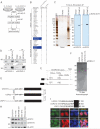ATXN7L3 and ENY2 Coordinate Activity of Multiple H2B Deubiquitinases Important for Cellular Proliferation and Tumor Growth
- PMID: 27132940
- PMCID: PMC4874879
- DOI: 10.1016/j.molcel.2016.03.030
ATXN7L3 and ENY2 Coordinate Activity of Multiple H2B Deubiquitinases Important for Cellular Proliferation and Tumor Growth
Abstract
Histone H2B monoubiquitination (H2Bub1) is centrally involved in gene regulation. The deubiquitination module (DUBm) of the SAGA complex is a major regulator of global H2Bub1 levels, and components of this DUBm are linked to both neurodegenerative diseases and cancer. Unexpectedly, we find that ablation of USP22, the enzymatic center of the DUBm, leads to a reduction, rather than an increase, in global H2bub1 levels. In contrast, depletion of non-enzymatic components, ATXN7L3 or ENY2, results in increased H2Bub1. These observations led us to discover two H2Bub1 DUBs, USP27X and USP51, which function independently of SAGA and compete with USP22 for ATXN7L3 and ENY2 for activity. Like USP22, USP51 and USP27X are required for normal cell proliferation, and their depletion suppresses tumor growth. Our results reveal that ATXN7L3 and ENY2 orchestrate activities of multiple deubiquitinating enzymes and that imbalances in these activities likely potentiate human diseases including cancer.
Copyright © 2016 Elsevier Inc. All rights reserved.
Figures







References
-
- Dedio J, Jahnen-Dechent W, Bachmann M, Muller-Esterl W. The multiligand-binding protein gC1qR, putative C1q receptor, is a mitochondrial protein. J Immunol. 1998;160:3534–3542. - PubMed
MeSH terms
Substances
Grants and funding
LinkOut - more resources
Full Text Sources
Other Literature Sources
Medical
Molecular Biology Databases
Miscellaneous

